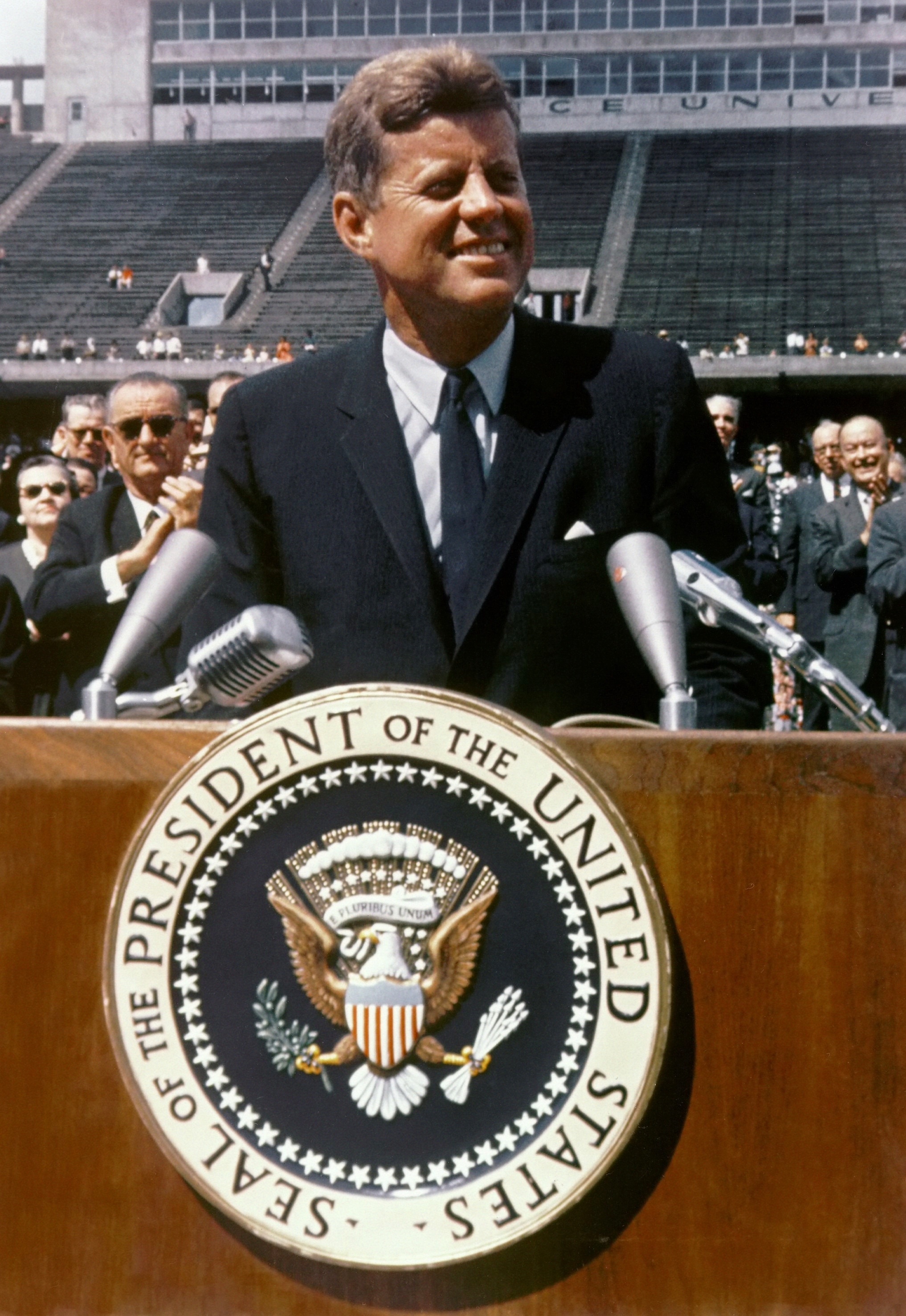
We choose to go to the Moon
"We choose to go to the Moon", formally the Address at Rice University on the Nation's Space Effort, is a September 12, 1962, speech by United States President John F. Kennedy to bolster public support for his proposal to land a man on the Moon before 1970 and bring him safely back to Earth. Kennedy gave the speech, largely written by presidential advisor and speechwriter Ted Sorensen, to a large crowd at Rice University Stadium in Houston, Texas. In his speech, Kennedy characterized space as a new frontier, invoking the pioneer spirit that dominated American folklore. He infused the speech with a sense of urgency and destiny, and emphasized the freedom enjoyed by Americans to choose their destiny rather than have it chosen for them. Although he called for competition with the Soviet Union, Kennedy also proposed making the Moon landing a joint project. The speech resonated widely and is still remembered, although at the time there was disquiet about the cost and value of the Moon-landing effort. Kennedy's goal was realized posthumously, in July 1969, with the Apollo program's successful Apollo 11 mission.
Date
Background[edit]
When John F. Kennedy became President of the United States in January 1961, many Americans perceived that the United States was losing the Space Race with the Soviet Union, which had successfully launched the first artificial satellite, Sputnik 1, almost four years earlier. The perception increased when, on April 12, 1961, Russian cosmonaut Yuri Gagarin became the first man in space before the U.S. could launch its first Project Mercury astronaut. [1] American prestige was further damaged by the Bay of Pigs fiasco five days later. [2][3]
Convinced of the political need for an achievement which would decisively demonstrate America's space superiority, Kennedy asked his vice president, Lyndon B. Johnson, in his role as chairman of the National Aeronautics and Space Council, to identify such an achievement. He specifically asked him to investigate whether the United States could beat the Soviet Union in putting a laboratory in space, or orbiting a man around the Moon, or landing a man on the Moon, and to find out what such a project would cost. Johnson consulted with officials of the National Aeronautics and Space Administration (NASA). Its new administrator, James E. Webb, told him that there was no chance of beating the Russians to launching a space station, and he was not certain that NASA could orbit a man around the Moon first, so the best option would be to attempt to land a man on the Moon. This would also be the most expensive option; Webb believed it would require $22 billion (equivalent to $172 billion in 2023) to achieve it by 1970. Johnson also consulted with Wernher von Braun; military leaders, including Lieutenant General Bernard Schriever; and three business executives: Frank Stanton from CBS, Donald C. Cook from American Electric Power, and George R. Brown from Brown & Root. [4]
Kennedy stood before Congress on May 25, 1961, and proposed that the US "should commit itself to achieving the goal, before this decade is out, of landing a man on the Moon and returning him safely to the Earth. "[5][6] Not everyone was impressed; a Gallup Poll indicated that 58 percent of Americans were opposed.[4]
Kennedy's goal provided a specific direction to NASA's Apollo program, which required expansion of NASA's Space Task Group into the Manned Spacecraft Center. Houston, Texas was chosen as the site for the new center, and the Humble Oil and Refining Company donated the land in 1961 through Rice University as an intermediary. [7] Kennedy took a two-day visit in September 1962 to the new facility. He was escorted by Mercury Seven astronauts Scott Carpenter and John Glenn, and shown models of the Gemini and Apollo spacecraft. Kennedy also viewed Friendship 7, the Mercury spacecraft in which Glenn had made America's first orbital flight. He took advantage of the opportunity to deliver a speech to drum up support for the nation's space effort. [8][9] Initial drafts of the speech were written by Ted Sorensen, with changes by Kennedy.[10]
Legacy[edit]
The idea of a joint Moon mission was abandoned after Kennedy's death,[28] but the Apollo Project became a memorial to him. His goal was fulfilled in July 1969, with the successful Apollo 11 Moon landing. This accomplishment remains an enduring legacy of Kennedy's speech, but his deadline demanded a necessarily narrow focus, and there was no indication of what should be done next once it was achieved. [1][17] Apollo did not usher in an era of lunar exploration, and no further crewed missions were sent to the Moon after Apollo 17 in 1972. Subsequent planned Apollo missions were canceled.[17]
The Space Shuttle and International Space Station projects never captured the public imagination the way the Apollo Project did, and NASA struggled to realize its visions with inadequate resources. Ambitious visions of space exploration were proposed by Presidents George H. W. Bush in 1989 (Space Exploration Initiative) and George W. Bush in 2004 (Constellation program).[29] After cancellation of Constellation, the future of the American space program seemed uncertain.[30]
Display[edit]
The lectern Kennedy spoke from as he gave his speech is on display at Space Center Houston.[31]